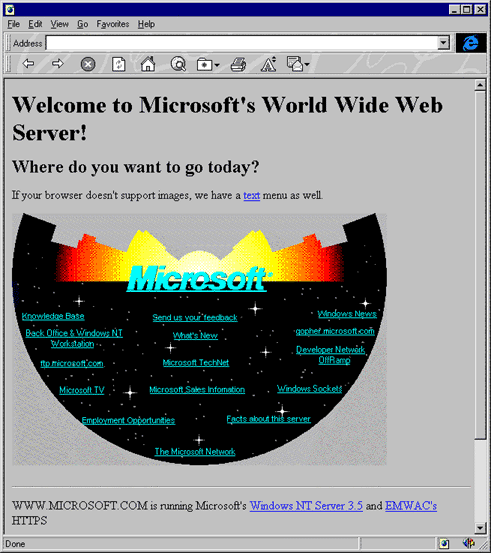THROWBACK THURSDAY: Welcome to Microsoft’s World Wide Web Server!
 Microsoft’s first homepage, full of Internet-y, Superhighway-ish; Tube-y; Worldwide-y goodness … launched 20 years ago TODAY: Link
Microsoft’s first homepage, full of Internet-y, Superhighway-ish; Tube-y; Worldwide-y goodness … launched 20 years ago TODAY: Link
There’s a great article on Microsoft.com tracing the evolution of Microsoft.com — consistently one of the top 10 Web sites on the Web since its launch: Link
In 1994, there was no World Series because of a strike by the Major League Baseball Players Association. Nelson Mandela made world news — and history — by becoming president of South Africa. TV shows like “Seinfeld,” “ER” and “Murder, She Wrote” peppered evening viewing fare in the U.S.
“Speed” was one of the more popular movies that year. But speed was not a reality for a very young World Wide Web in 1994, with pokey dial-up modems the norm for getting onto the Web. There were only a few thousand websites then – compared to nearly 1 billion now – and Microsoft was among them. In the 20 years since it has been on the Web, Microsoft.com has remained in the top 10 most-visited websites worldwide.
Twenty years ago, there was no Facebook, of course, no eBay, no Amazon, no Wikipedia. It was Web less-than-1.0.
In 1994, among the reasons Microsoft started a website was to put its growing Knowledge Base online. At the time, the company managed support forums for customers on CompuServe, one of the earliest major Internet dial-up service providers.
“We had started to build up a community there; people would answer questions for each other,” recalls Mark Ingalls, a Microsoft engineer in 1994 who would become Microsoft.com’s first administrator. He was also the only website employee at that time, other than his boss. But the staff doubled early on, when Steve Heaney was hired to offer vacation relief, Ingalls says.
In terms of “Web design,” the notion, much less the phrase, didn’t really exist.
“There wasn’t much for authoring tools,” Ingalls says. “There was this thing called HTML that almost nobody knew.” Information that was submitted for the new Microsoft.com website often came to Ingalls via 3-1/2-inch floppy disks.
“Steve Heaney and I put together PERL scripts that handled a lot of these daily publishing duties for us,” he says. “For a while, we ran the site like a newspaper, where we published content twice a day. And if you missed the cutoff for the publishing deadline, you didn’t get it published until the next running of the presses, or however you want to term it.”
#TBT #ThrowbackThursday
